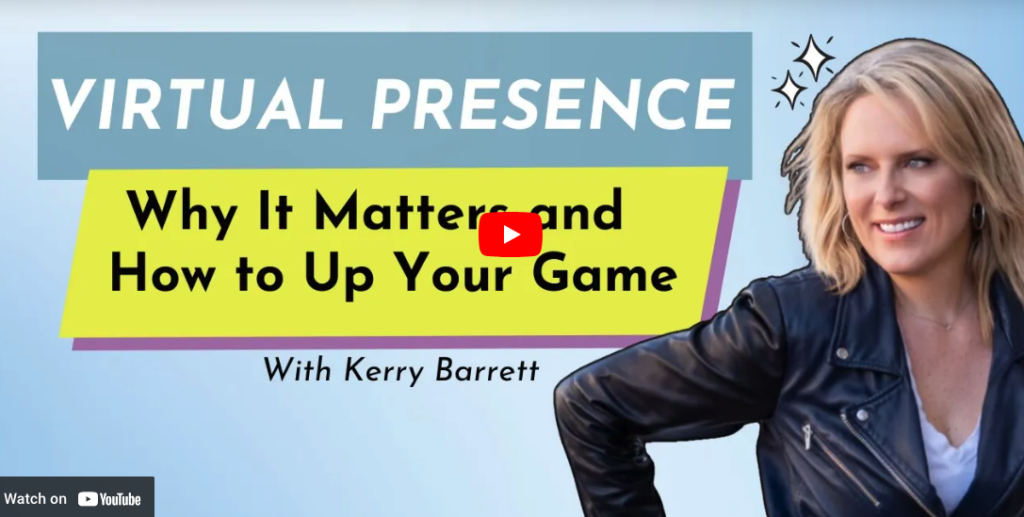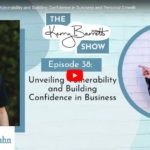
Discover the art of projecting your leadership style, capabilities, and confidence through digital mediums such as video calls, social media, online meetings, and live streams. Your virtual presence directly impacts your ability to influence, engage, and gain credibility with your team, clients, and prospects. Gain insights into the essentials of clear, concise, and articulate communication, as well as fostering engagement and inclusivity in a hybrid audience setting.
Transcript
If you’re struggling to understand why virtual executive presence or virtual presence is important and how to make yours better, this video is for you. Whether you are leading a team, running a business, climbing the corporate ladder, trying to close sales, you’re a founder or a business owner, your virtual presence and executive presence is important.
And that’s what we’re gonna dive into right here. So first things first, What exactly does virtual executive presence or virtual presence mean? It’s how you project your leadership style and capabilities, your confidence through any sort of digital medium. So that means video calls, social media, video posts, it means online meetings, virtual events, hybrid events, any sort of communication that you’re doing that includes your voice and your face through some sort of lens. It can be live. It can be recorded. It can be through a traditional media outlet such as radio or television or cable.
It can also be shown and demonstrated through podcast interviews and live streams and panel discussions. It’s important because the way that you present yourself virtually really does impact your ability to influence, your ability to lead, your ability to make an impression, and become memorable. It influences your credibility, how much buy in your team, your employees, or your clients or prospects have in you, and it also can create a more engaged workforce. It can bring people together, especially when many of the workforce or much of the workforce is still remote.
There’s a lot of statistics out there about how much productivity and bottom line revenue is lost through poor communication, ineffective communication, those numbers are increasing with virtual communication. And it’s because not only do many of us misunderstand the challenges of communicating through a lens nor do we know how to mitigate those challenges. And the people on the other side of the lens are also struggling with the same things, not only how to communicate but also how to receive it just as well. There’s a lot going on on both sides.
The data says that 1,000,000,000 dollars are lost in the United States alone every single year based on poor communication. The most recent number, and this doesn’t even take virtual communication into account, is that around $14,000 is lost per employee in the United States because of poor communication. So how do you ensure that you have a good virtual executive presence?
The basics, that means good lighting, clear audio, a professional background. That stuff though is very easy to fix. Once you understand what the problems are, it’s a simple matter of perhaps readjusting where you’re sitting or buying some inexpensive gear and having it ready to go.
The real challenge is with communication. And as we know, it means you need to be clear, concise, and articulate. Often, it’s not just what you say. It’s how you say it and how you deliver it. One of the biggest challenges people struggle with when they are virtually communicating is that they just don’t know how to be memorable. And that’s especially important if you are talking to a cold audience that you’re looking to bring in as a potential client.
It’s also important, though, if you’re talking to internal or external stakeholders, It’s important to create an engaged workforce. It’s important to demonstrate leadership and to have people trust you and buy into what you’re saying. It does not mean that you have to be perfect, but you have to be understandable. You have to be relatable, and you do need to be memorable.
And those things are created through not just what you say, but how you say it. And lastly, you don’t wanna forget about engagement. So you are encouraging participation. You’re asking questions. You’re showing genuine interest in your audience or your team. It also means that if you have an audience that is hybrid, there are some people that are there with you in the room, and then there are some that are joining you from a remote location, the folks who are attending remotely feel just as part of that group as as the ones who are in the room with you feel. You’re not forgetting them. You’re not ignoring them.You are addressing them, and you’re bringing them into the conversation, which is very challenging for a lot of people because your audience is bifurcated. It’s split.
And we have a tendency to talk to the people who are in front of us without recognizing or addressing or even perhaps looking at the people who are joining us remotely. Executive presence and virtual executive presence is not just about looking good. It’s not just about sound and taste. It doesn’t mean that you need to show up in a suit and tie every single day, but it is about making an impact. It is about building relationships, and it is about leading effectively and efficiently in a digital world. It’s about creating an environment for not just your team, but also your clients and your potential clients as well.
And it’s communicating effectively internally and externally. Virtual executive presence is applicable in every single scenario. Creating that presence does sound to a lot of people somewhat as a performance. And I want you to remember that communication is in fact a performance.
It’s a performance designed with your audience in mind. So you are delivering using your performance skills that’s most likely to land that message in a way that they’re going to understand and receive it. I work on exactly this with so many of my clients in so many teams. If you’d like to schedule an on camera confidence strategy call, use the link below in the comments.




